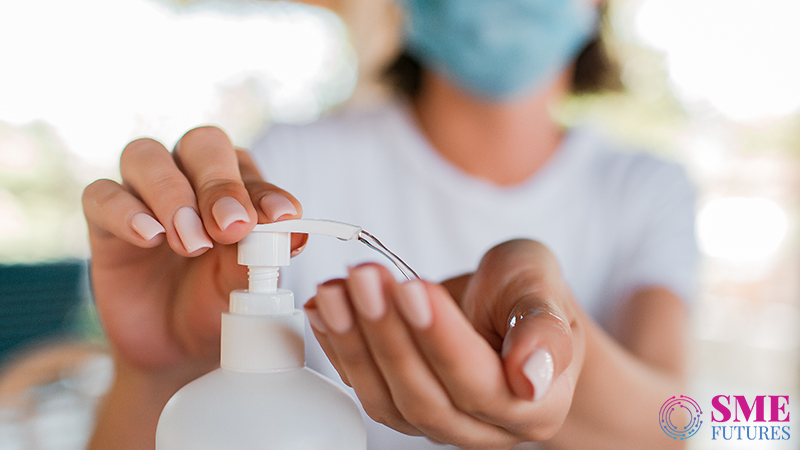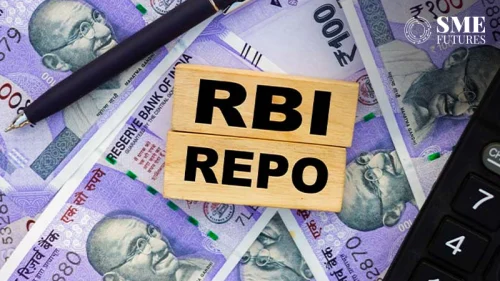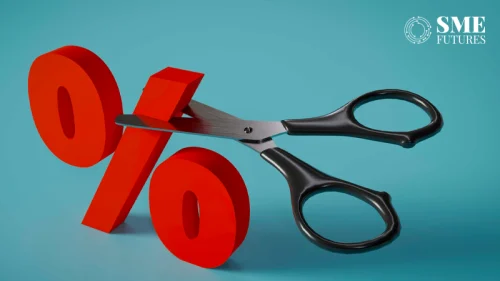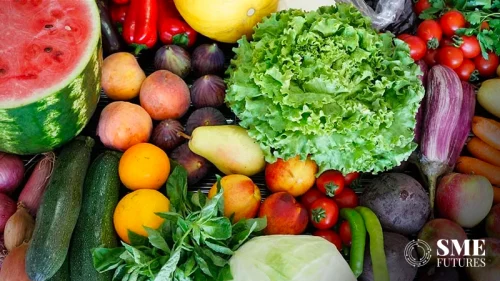Last year, one in four households purchased Reckitt Benckiser’s Dettol as a hygiene product, almost 1.4 billion times. With a surge in sales, the brand witnessed 39 per cent growth, which was more than double of its 2019 growth. In Kantar’s brand footprint rankings, Dettol made it to #16 in 2020 from #27 in 2019.
With the advent of the second wave, the sales of products from RBs key hygiene portfolio, which includes Lysol, Harpic, Lifebuoy, Air wick and Finish among others, are shooting up their growth figures. In a statement, the company says that their sales in the March quarter grew by 28.5 per cent and that accounted for 47 per cent of their Rs 144,683 crore yearly revenue.
Other FMCG giants such as ITC, Godrej, HUL, Himalaya etc are also witnessing a great demand for hygiene products. In fact, the health and hygiene market has become so lucrative that almost every local brand and health tech start-up out there is looking to tap into this opportunity.
In fact, this exemplary growth rate has induced market analysts to predict that the health and hygiene market will grow at a rate of 4.5 per cent during the forecast period of 2020-25, globally. As per Industryarc Research, the health and hygiene market stood at $140.5 billion in 2019.
While in India, the personal hygiene care market is estimated to grow by $15 billion by 2023. According to Statista, the market in 2019 accounted for $11.5 billion.
It is a growth story for brands
“Unfortunately, it has taken the pandemic disrupting millions of lives and families across India, for the public to understand that how maintaining good hygiene now has a direct impact on our health and is now a necessity rather than a choice,”
says Varun Mukhi, Founder and Director at Vetro Power—maker of nanotech and clean-tech enabled hygiene products.
Earlier, despite a general awareness about its importance, hygiene consciousness among the masses was not too high on their priority lists.
But due to the level of global exposure that this topic has gained recently amidst the pandemic, people’s perceptions about sanitation and hygiene have undergone a drastic change. Now they are more serious about it.
The sudden increase in awareness about cleanliness and sanitisation has also led to a market growth for health and hygiene players which is unprecedented. During the first wave in March 2020, sanitisers, which were beginning to be used frequently by people, sold to a magnitude never recorded before (Jan-Mar).
The product saw a 144 per cent growth in sales compared to its sales in 2019 in India. This was followed by liquid hand wash with a growth of 42 percent for the same period, according to Statista. Wipes, disinfectants, detergents, floor cleaners and soaps were flying off the shelves like never before, which also created a demand-supply gap for a short span, while their prices also jumped up two-fold.
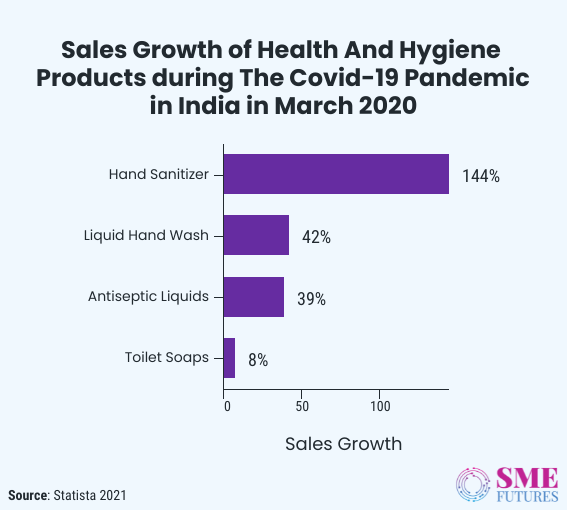
The demand was such that FMCG companies doubled their production of health and hygiene products. Many seized this opportunity and turned their assembly lines into hygiene product manufacturing lines.
By the end of the year, sanitiser penetration was up from 1 per cent (Jan to Sept 2019) to 45.6 per cent for the same period. While the overall hand and body wash segment had grown by 12.6 per cent by the end of Q3, with full year category sales for 2020 likely to be over 15 per cent, as per Kantar’s report.
In fact, due to the dramatic refocus on hygiene, the Indian FMCG sector saw the launch of 1,897 new products during March-August in 2020. According to a Nielsen market research, this was an 18-fold jump for the Indian health and hygiene market. Before the pandemic, only 102 products were introduced from September 2019 to February 2020.
Hygiene companies are on roll
Meanwhile, along with the leading health and hygiene players, clean tech start-ups and innovative brands also grew overnight and cornered some of the market share as this is a never seen before opportunity for them too.
One such brand is Clensta—a health & hygiene start-up in association with IIT Delhi, which launched Clensta COVID protection lotion and hand sanitiser in 2020.
Puneet Gupta, its founder & CEO says, “Clensta Products are performing up to our expectations. We had seen a surge in demand during the pandemic last year. Foreseeing the demand for them this year as well, we raised our production capacity to meet it. The demand rose up to 4x since the last financial year and we feel obliged that we were able to accomplish this and cater to the increased requirements of the country,”
Seeing the growth of his products, Gupta’s future plan is to provide personal care hygiene solutions instantly at any place and time with the consumer not needing to use a single drop of water. Also, Clensta’s vision includes setting up a manufacturing unit to develop a new industrial base, creating more employment in the process. Their other focus area is mitigating plastic pollution by creating cleaning solutions for anti-microbial cleaning without using any plastic in their packaging.
“Clensta is going to disrupt the entire home care industry worldwide by solving the hygiene problems of all, instead of solely catering to a small niche market. We intend to target the entire 7.7 billion consumers globally through our various upcoming consumer staple homecare products such as toilet cleaners, hand washes, utensil cleaners, fabric cleaners, multipurpose cleaners, vegetable cleaners and more with up to a 67 per cent reduction in price,” he tells us.
Another player in this segment, Vetro Power, is now focusing more on building a loyal cohort of customers and is experiencing major sales as well. “2020 has been a transformative year for Vetro Power,” says Mukhi, its founder.
The company which was set up in March 2021 has launched two nanotech-based products, Nano anti-microbial shield—a disinfectant and a fruit and veggie wash. “Products like fruit & veggie wash, hand wipes, surface disinfectant wipes and many more were completely unheard of and a niche product prior to the COVID-19 pandemic. But they are now widely used. We have seen a boost in revenue and sales across both our domestic and export markets; the most important change is the shift in the dynamics of consumption,” he continues.
Talking about his company, Mukhi says, “The focus is on building a loyal cohort of customers who are interested in the brand, the story, the technology and the vision that we have. Education and knowledge are equally important for sales. We want our customers to know why we are better and safer and that the ingredients we use are preventative against the virus. We’ve been building a new refreshed brand identity for all of 2020 and it is now taking shape for 2021!” he asserts.
Seeing the potential of the hygiene market in India, numerous foreign brands with innovative wellness and hygiene products are also entering the Indian market. A recent newcomer in India is a French brand, Puressentiel, which was launched last year amidst the pandemic. The company has a range of air and nasal sprays in the range of Rs 300 to Rs 4,000 for sale on e-commerce websites.
Karina Kapoor, Brand Head, Puressentiel-India talks to us, “In my opinion, international niche brands help bring in innovation and further push the economy forward, also compelling the domestic players to develop their products internally and compete in the international arena as most of the raw materials and labour are Indian. And a slightly aspirational and premium French brand, Puressentiel, is the need of the hour and is only gaining in popularity as we gradually introduce new ranges to the Indian market.”
Talking about their brand performance in India, Kapoor says, “Puressentiel is a French, over-the-counter plant-based, aromatherapy/wellness and lifestyle brand. As it was launched in India in the midst of COVID, it’s true potential remains untapped due to the Indian regulatory limitations.”
Explaining the reason for this, she says, “The brand falls under the cosmetics category and not the drugs category (prescription medicine). Thus, the lack of an organised and formal pharmaceutical sector has delayed the brand from finding its positioning in the market.”
However, according to Kapoor, the brand is doing well enough, and its nascent wellness category is slowly gaining in popularity, especially due to the pandemic and its requirements. “Repeat orders and our satisfied customers endorse the authenticity of the products which further strengthen our brand equity. Also, e-commerce and the gourmet chains strategy has seemed to work for the brand,” she avers.
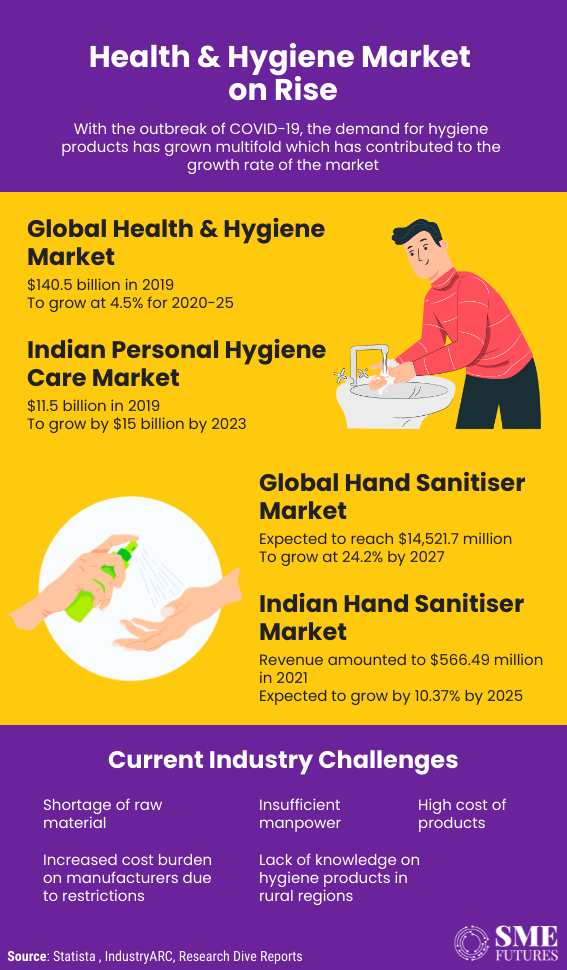
Growth is trending due to hygiene
The current consumer trend is—most shoppers are attuned to buying those products that come with added hygienic benefits. Hence, the health and hygiene players are seeing good numbers. At the same time, the trend is also rubbing off on other hygiene market segments such as sanitaryware, bathroom ware and accessories and even hygiene packaging.
“People are more and more aware of the necessary steps to complete personal hygiene. This awareness has instilled in them a need to invest in accessories which promote hygiene and sanitation. Social media has played a big part in this. Washroom automation accessories contribute almost 70 per cent when it comes to hygiene in public places,” says, Viknesh Jain, CEO & MD, Euronics.
Euronics, a leading washroom accessories brand earned roughly 45 per cent of its total revenue from their Covid Prevention Accessories range last year. Moreover, its touchless washroom accessories are garnering greater traction.
Jain tells us, “The touch-less washroom accessories space and the COVID prevention accessories space, which constitute the top line in our product portfolio; have increased by 40 per cent for us.”
Coming to 2021, sanitary ware and accessories businesses are seeing reignited demand, especially for touchless products after a brief period of demand saturation last year. Jain, further elaborating on the current market scenario, says, “The demand for sanitary products was considerably high from April 2020 to July 2020. It took a drop in the following months since the number of active cases went down. Towards the end of March 2021, the demand was again high as this is hugely related to the severity of the pandemic and the growth in the number of active cases. There was a massive influx of demand from the corporate sector as offices began to open. But the second wave has put a hold on that.”
There are challenges too
At the same time, despite this exponential growth and a high number of sales, sanitary and hygiene players are facing a few challenges.
Since lockdowns and restrictions are now a part of life, there is a constant struggle to keep their operations running smoothly in tandem with these on and off restrictions. Jain, sharing his own experience, says, “The present times have led us to introspect about what can be improved, as we are all striving to make the maximum out of the minimal resources that are available.”
Most of the worries are about raw materials and the labour crunch.
“Currently, the challenges that the market is facing are a shortage of raw materials and insufficiency of manpower. The cost of raw materials also plays a huge role as it has increased 30-50 per cent in just the last 10 months. So, procuring them is definitely challenging,” Jain tell us.
At the same time, manufacturers have to ensure that the supply side continues to function, even if the manufacturing input is sabotaged. Presently, they are giving importance to fulfilling the supply side so that the output does not lag because of it, even if it is at a high price.
Another challenge concerns the small players. As digital is the new battleground today, the right strategy can do wonders and the lack of one can hit you massively. “Whether you are a start-up brand, manufacturer or incumbent, digital allows a level playing field. The challenge lies in constant innovation, and in implementing the right kind of business strategies,” suggests Mukhi.
On the other hand, after talking to an industry insider, a sales professional for a hygiene product, we gained some interesting insights. Requesting anonymity, he said that it has been tough for him to fulfill his sales targets, as the market is already overcrowded, “Lately, it has been too difficult to achieve the high targets that the company has set for us. The reasons for that are quite a few. The first being that the market is saturated or rather over-crowded with similar hygiene products. Second, corporate demand is almost nil due to the lockdowns. Now, due to offices being closed, we are not able to sell in bulk, and are dependent on domestic demand, which is making my job tough,” he says.
Now with corporate profits going haywire, sales professionals already working on low salaries, are worried about their financial state of affairs.
This is what the other side of the coin looks like.
Hygiene-tech is the buzzword
Even as there are challenges, there are several positive aspects to the situation as well.
The pandemic has shifted the paradigm on how tech solutions can be used. Nowadays, technology is omnipresent in every aspect of our lives, and the health and hygiene sector are no exception.
The industry is calling it hygiene-tech.
With the influx of newer and newer hygiene trends and products like self-cleaning surfaces, anti-bacterial, anti-viral and nanotech hygiene products, haptic solutions, UVC appliances and more in the market, companies are even hiring hygiene engineers to innovate and create novel solutions and products.
In short, technology is playing a significant role in the tech makeover of this market, and it is attracting new age customers.
“Consumers now value hygiene or ‘hygiene-tech’. They are aware and continue to read and learn more as the environment around us changes; and they are looking for smarter products,”
says Mukhi of Vetro Power
Mukhi opines that consumers are looking for clean products, i.e., products that are made without harsh chemicals, are sustainable, even re-usable and cost effective at the same time. “Vetro Power has always focused on innovation, such as our 90 Day Single Spray Surface Disinfectant. This is a one-time spray solution, which self-disinfects a surface for 90 days. This kind of innovation allows us to build a strong and loyal customer base,” asserts Mukhi.
Tech innovations can also be seen in a range of hygiene products such as automatic dispensers, panels, sensor taps and automatic or sensor operated toilets and bidets. Interestingly, you can find shoe cover dispensers and even UV sole sanitising machines in the market too.
From an industry perspective, these innovations have the potential to create an altogether different market of contactless or touchless products within the health and hygiene segment.
“I definitely believe that contactless accessories have gained prominence because COVID has permanently changed the habits of people. They are willing to invest in them as they now know the severities of contamination through touch, especially in public places. These products have the potential to become a unique market segment as people are keen to convert their equipment from manual to automatic,” says Jain of Euronics, one of the front runners in the germ-free accessories market.
Technology should go hand in hand with sustainability
The hygiene industry is also working towards incorporating sustainability within their technology.
Given the fact that natural resources are limited, the sanitation sector is facing increasing pressure, especially due to the impacts of climate change. This calls for a need to increase the sector’s resilience and sustainability.
Here, innovation and technology have a large role to play in mitigating the challenges of water scarcity, safety and efficiency. For efficiently running utility operations, monitoring and analysing data and analytics, hygiene-tech is just the answer.
“The latest waterless technological innovations in the sector can help advance such efforts in the near future. And we are working on the same,” says Gupta of Clensta.
Clensta is planning to introduce a new range of home care products based on EBDC (Ethylenebisdithiocarbamate) technology. “We aim to continue with these waterless innovations for the prospect of transforming awareness of plastic waste into concrete action towards sustainability. We are bringing in a broad range of expertise to advance the knowledge and application of cost reduction on single-use plastic products and are working with experts to apply it,” Gupta tells us.
For Kapoor, sustainability is a growing trend which is not only a personal choice but should be mandated for various global concerns. “It is prevalent in almost all sectors, and even in our daily lifestyles,” she says. “Consumers are always looking out for new and innovative trends as we ape the West and with a growing disposable income, especially among the youth, the sales of and interest is such products has increased,” she further says.
Her brand’s current target market are millennials or netizens who have access to everything with just one click.
“Being a 100 per cent essential oil, plant-based range of health remedies, Puressentiel fits perfectly in this category. As this has become the need of the hour, the brand is forecasted to reach a bigger customer base and is sure to see an incremental increase in sales both offline and online,” she avers.
Hygiene will continue to be important
Fact is that the need for hygiene was always there, but the pandemic has heightened this need, and this in turn is contributing towards the growth of this industry.
Hence, governments around the globe are taking initiatives to ramp up the manufacturing and supply of personal hygiene essentials like sanitisers on a large scale. A shift in buying patterns has resulted in a tremendous increase in sales of hygiene and sanitary products like disinfectants, sanitisers, hand washes and sterilizers.
The other major factor driving the market growth of personal hygiene products is the rising disposable income of consumers coupled with a growing willingness to pay for these products.
“The rising desire for personal beautification and the growing consumer demand for gender specific hygiene products such as conditioners, shampoos, shaving kits, face masks, face peels and other products will fuel the demand for personal care products, thereby further augmenting this market growth,” Gupta says.
He also adds that the intense competition between global leaders of personal hygiene products and advanced product launches will further stimulate the market growth.
“Premium products are gaining immense popularity in the developed world as well as in developing countries. This will impel consumers to buy the best rated and high-end products available in the market, thereby fostering growth in revenues of the market players globally,” he opines.
Overall, the Indian health and hygiene market has the potential for rapid economic growth. The government-led initiative has helped manufacturers to embrace technology such as AI to produce better and smarter products. “The hygiene market is becoming more and more attractive to investors, with technology led innovations helping to penetrate the second and third tier markets. Manufacturers are already motivated to disrupt the traditional Indian hygiene models. The future seems to be very bright,” concludes Jain of Euronics.

